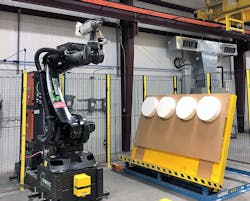Robot Milling Speeds Pattern, Mold Production
QESC LLC, a Houston steel and gray iron foundry, has installed a robot to help produced rapid-prototype molds and patterns. The foundry stated the six-axis KUKA RMC90 robot will help to speed casting production, with more economical and accurate results.
The onetime Quality Electric Steel Castings plant produces carbon-, alloy-, and stainless steel castings at up to 1,000 tons/month for oil-and-gas markets, including large valve bodies, gears, and connecting rods. It was acquired by Lawton Standard Co. in January of this year for an undisclosed price.
“The decision to place the KUKA robot at the QESC facility was based on its capability to pour both steel and iron materials,” according to Lawton Standard CTO Blake Albritton. “Besides adding versatility to QESC, this allows for further refinement and assessment of the technology for use at our other foundry locations.”QESC produces patterns in several materials, including polystyrene foam for low-volume casting programs for which pattern storage is not optimal, or to produce prototype castings. As an alternative to wood pattern tooling, polystyrene patterns are routed from large foam blocks, and the KUKA robot pattern mill includes mold handling and dust collection systems that promote safe and environment-friendly processing.
Another time-saver with the robot involves milling in sand-mold blocks. Wood and/or polystyrene pattern tooling is reduced or eliminated. The robot can create most mold geometries that typically would involve multiple cores or structural parts, according to QESC, and so robot-milled sand molds can produce more dimensionally accurate castings. Lead-times are reduced because tooling requirements are minimized or eliminated.
QESC pattern-shop manager Keith Faulkner said, “One of the biggest benefits to the customer is the ability to make a part that exactly matches a customer drawing. Since we don’t have to pull a pattern from a sand mold, we don’t have to consider adding a draft to a part.”
Faulkner, who also is the programmer for the robot pattern mill, continued: “The robot can move on six axes, so features like pockets and undercuts that would normally require cores can be cut directly into the sand. The result is a dimensionally accurate casting in less time.”

